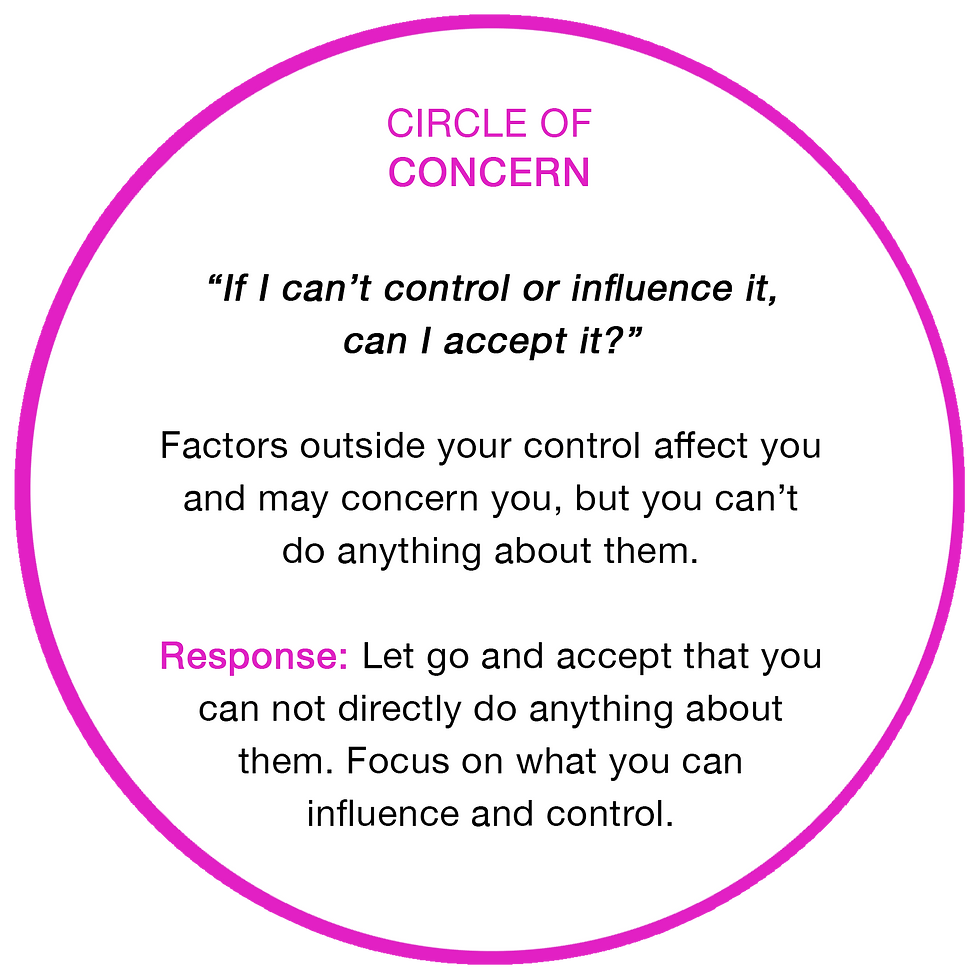How to Apply The 3 Circles of Influence in a Marketing Strategy
- Zakia Baniabbassian

- Feb 2, 2024
- 3 min read

The concept of the "three circles of influence" is associated with Stephen Covey's book, "The 7 Habits of Highly Effective People." The three circles represent areas that individuals or organizations have control over, can influence, or are outside their control. While Covey originally applied this concept to personal effectiveness, it can be adapted and applied to marketing strategy as well. Here's how you can apply the three circles of influence in your marketing strategy:

Circle of Control:
This circle includes aspects that are directly under your control. In marketing, these may include your website, social media channels, email campaigns, and content creation.
Focus on optimizing and enhancing these elements to ensure they align with your overall marketing goals. For example, you can control the quality of your website content, design, and user experience to create a positive impression on visitors. For example:
Website Optimization: Ensure your website is user-friendly, has relevant and engaging content, and is optimized for search engines. You have direct control over your website's design, functionality, and content.
Content Creation: Develop a content strategy that aligns with your brand, provides value to your audience, and is consistent across different platforms. Content creation is within your control and plays a crucial role in attracting and retaining customers.
Email Marketing: Your email campaigns, including content, design, and frequency, are under your direct control. Use email marketing to nurture leads, communicate with your audience, and drive specific actions, such as purchases or sign-ups.

Circle of Influence:
This circle includes elements that you may not have direct control over but can influence. In marketing, this could involve partnerships, collaborations, influencer marketing, and public relations.
Identify key influencers and partners in your industry. Build relationships and work on strategies to mutually benefit each other. By leveraging the influence of others, you can extend the reach of your marketing efforts. For example:
Partnerships and Collaborations: Identify potential partners or influencers in your industry and build relationships. Collaborate on joint ventures, co-marketing campaigns, or mutually beneficial projects to expand your reach through the influence of others.
Social Media Engagement: While you may not control social media platforms, you can influence your brand's presence by engaging with your audience, collaborating with influencers, and creating shareable content. Social media partnerships and collaborations can enhance your brand's visibility.
Public Relations: Develop relationships with media outlets, bloggers, and influencers who can help shape public perception of your brand. Positive coverage and endorsements from influential sources can significantly impact your brand's reputation.

Circle of Concern:
This circle represents elements that are outside your direct control or influence. These may include market trends, economic conditions, and the actions of competitors.
While you can't control these external factors, you can monitor and adapt your marketing strategy based on changes in the market. Stay informed about industry trends and be agile in adjusting your approach to align with the evolving landscape. For example:
Market Trends: Stay informed about industry trends, consumer behavior, and market dynamics. While you can't control these trends, understanding them allows you to adapt your marketing strategies to align with the evolving landscape.
Competitive Landscape: Monitor the actions of competitors, including their marketing strategies, product launches, and customer feedback. Although you can't control their decisions, awareness of the competitive landscape helps you position your brand effectively.
Economic Conditions: Economic factors, such as inflation, interest rates, and overall market conditions, are beyond your control. However, being aware of economic trends can help you adjust your marketing budget, pricing strategy, and overall business approach accordingly.
Application in Marketing Strategy:
Focus on the controllable elements: Allocate resources and efforts to optimize your website, create compelling content, and improve the user experience. Ensure that your owned media channels are effectively managed and reflect your brand identity.
Leverage influencers and partnerships: Identify influencers or organizations that align with your brand and can help amplify your message. Collaborate on co-marketing efforts or influencer campaigns to reach new audiences and enhance your brand's credibility.
Adapt to market changes: Keep a close eye on industry trends and competitive actions. Be ready to adjust your marketing strategy and tactics based on shifts in consumer behavior, technological advancements, or other external factors.
By applying the three circles of influence to your marketing strategy, you can prioritize efforts where you have the most control, strategically leverage influencers and partnerships, and adapt to external factors to maximize the effectiveness of your overall marketing approach. ZB Communications is here to guide you towards unparalleled success in your marketing endeavors. Contact us now for personalized strategies aligned with your goals, elevating your business to new heights.




